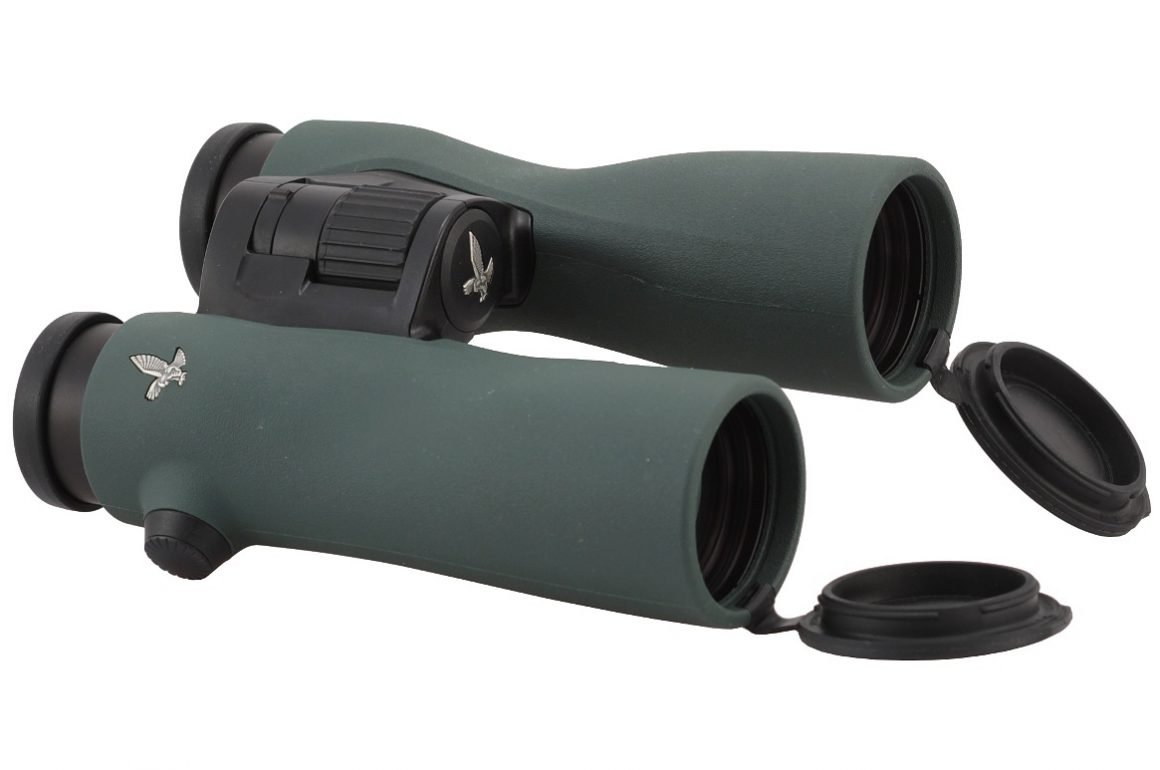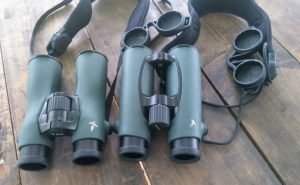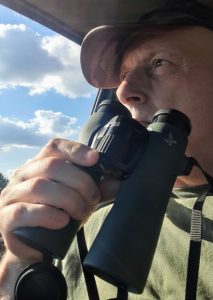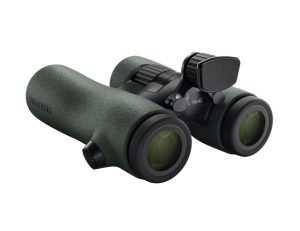
“I don’t know anyone else crazy enough to try 12s,” my friend answered when told that I am about to test NL Pure 12×42. And he stood behind his words: he bought an NL 8×42.
What do you think? Are 12s right for birding? Or have you ever birded with 12s? Back in the 1990s, I did.
And did it mostly from a canoe, which responds to every move you make, multiplied by the river currents, making it ever harder to use the narrow field of view (a.k.a. FOV) of the 12s. With such a background, my decision to test the new birding frontier of Swarovski 12×42 extra-wide FOV binoculars didn’t appear strange at all – to me, at least.
There is another reason I was curious about the 12s: I have mobility issues. If you spot a small bird with, e.g., 8s, you will walk towards it until you get a better view. But nowadays I bird not only by car, but actually from the car, waiting for the bird to show itself better. Or fly away, whatever happens first. So I asked myself would a higher magnification (than my usual 8x) prove to be a significant improvement?
I tested the 12s at my usual stomping grounds where I am used to local species and landscape, at their usual distances from the observer, so I could immediately spot a different experience. There was one more aspect I wanted to test: I usually carry a scope with me, but with 12s I left the scope behind, wanting to see if a higher magnification can replace the scope at shorter to moderate distances.  But, before I share my (very subjective) impressions with you, let me introduce the NL 12×42. Prior to NLs, Swarovski never made 12s in 42 mm version, so for comparison I will choose the nearest well known birding bins from Swarovski, the legendary EL 10×42 W B.
But, before I share my (very subjective) impressions with you, let me introduce the NL 12×42. Prior to NLs, Swarovski never made 12s in 42 mm version, so for comparison I will choose the nearest well known birding bins from Swarovski, the legendary EL 10×42 W B.
Nothing short of revolution in binoculars making, these two, 12s and 10s, have practically the same FOV at 1,000 m: 12s 113 m/1000m (339 ft/1000 yds) and 10s 112 m/1000m (336 ft/1000 yds). In other words, if you go for a higher magnification from 10s, you need not sacrifice the FOV at all!
Surprisingly, the shortest focusing distance of 12s is 2.6 m (8.5 ft), while with 10s it goes to 3.3 m (10.8 ft). Totally irrelevant, some may say, but if a bird is on the other side of that bush next to you, with 12s you may blur the bush and sharpen the bird, while with 10s you will blur everything.
The light transmission is practically the same, 12s at 91% and 10s at 90 per cent. 12s have a higher twilight factor of 22.4, compared with 20.5 of 10s. The length is practically the same (+/- 2 mm) and the weight is the same (840 g/29.5 oz).  And so, eager to get my first-hand impressions, in mid-June I found myself birding my local patch. The views were bright and crisp, focused edge to edge. Since I was at a place I am familiar with, plus I am used to 8s, the opposite shore and poplar plantations were suddenly much closer and the birds seemed confusingly large.
And so, eager to get my first-hand impressions, in mid-June I found myself birding my local patch. The views were bright and crisp, focused edge to edge. Since I was at a place I am familiar with, plus I am used to 8s, the opposite shore and poplar plantations were suddenly much closer and the birds seemed confusingly large.
Jumping from 8s to 12s, I had that weird feeling that all birds are bigger than I know them, so their sizes confuse me and I can’t use them as a character for ID! Despite the stronger magnification, because of the now confusing sizes, distant shorebirds at first posed a challenge (it takes some time getting used to now enlarged birds). But seeing larger than I am used to has its advantages too, e.g. Green Sandpipers at 50 m looked big, every detail visible, as if I were looking at them with at least 20x or more! Distant birds become more noticeable, so instead of the usual 10 swifts now I had 60.
On the other hand, the apparent field of view narrowed – again, I am used to 132 m of FOV at 1000 m (396 ft/1000 yds) – and focusing from a far to a nearby bird takes more turns of the focusing wheel. For example, 3 Green Sandpipers in a swift-like flight at the opposite side of a car gave me a hard time when I tried following them in what I perceive as a narrow FOV (113 m/339 ft/1000 yds of 12s vs. 132 m/396 ft of my usual 8s), and they kept slipping away! Testing 12s later in an orchard, I noticed how the narrow depth of FOV requires more frequent focusing (again, compared with my every day 8s). Still, 113 m/339 ft at 1000 m/yds is the widest FOV of any 12s ever made.
I also asked my cousins for their impressions. Mirjana works at a media agency and edits loads of photos daily. The first thing she noticed was how crisp the image is. Milan is a photojournalist who was stunned how strong magnification is and yet, how bright the image is, plus how nice the outer rubber feels to the touch and how comfortable the barrels are. Finally, the forehead rest is an innovative way of keeping one’s binoculars steady. It is particularly useful with larger magnifications, such as 12x, but my friend from the beginning paragraph happily uses the forehead rest on his 8s and has only superlatives for it.
Finally, the forehead rest is an innovative way of keeping one’s binoculars steady. It is particularly useful with larger magnifications, such as 12x, but my friend from the beginning paragraph happily uses the forehead rest on his 8s and has only superlatives for it.
Yet, I had hardly used it myself, because of the way I bird, from a car, always resting my elbow on the open window so it is as steady as can be. Also, in the case of a raptor high in the sky, I raise my binoculars upward more than my eyes or head, and using the forehead rest inside a car in such a situation limits how high I can raise my bins before the rest presses against my forehead restrictively. So, it may not be a thing for me, but from all the comments I heard, it comes highly recommended.
To conclude, NL Pure 12×42 comes as a strong and highly specialised beast, great for waterfowling and waterbirds in general, than for raptors, and for open habitats such as marshes, grasslands, open savannas, mountain-tops and deserts, and sea-watching. It also works well with scrub and hedges, e.g., I observed a Barred Warbler in a bush, constantly obscured by leaves, poking its head and barred chest only briefly, which I saw only thanks to strong magnification.
Expectably with NL 12s, keep away from forests or woodland-savannas, for which the FOV is not wide, nor deep enough, and it becomes hard to locate the bird before it flies off, or to focus it in time. For such habitats, the right beast is NL 8×42, with unbelievable width and depth of FOV. NL 10×42 comes as an universal middle ground between the two extremes.
Just like the ELs in 1999, the NL Pure series represents another significant milestone in birding optics. While I do not have a decisive answer whether a higher magnification would prove to be an utterly significant improvement (it is both “yes” and “no”), for the second question the answer is “yes”: for shorter distances 12s can replace the scope!
In conclusion, choose your model after the dominant habitat type you usually bird. Since there is no need to sacrifice FOV, I am considering 10s. Similarly, if you are already using 10s, do consider 12s. Yet, jumping from 8s to 12s is not something I would recommend. Try the NLs, but beware: you will fall in love.













Leave a Comment